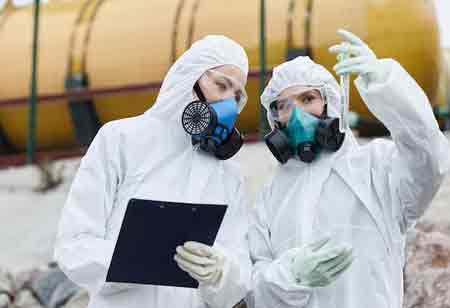Thank you for Subscribing to Environmental Business Review Weekly Brief
Transforming Carbon Waste into Wealth: The Evolving CCU Industry
A major obstacle in capturing and using carbon is the cost-effectiveness and efficiency of the technology employed. Today's methods used to capture CO2 are costly and energy-intensive, particularly in major industrial sites.

By
Environmental Business Review | Monday, March 24, 2025
Stay ahead of the industry with exclusive feature stories on the top companies, expert insights and the latest news delivered straight to your inbox. Subscribe today.
The energy transition's carbon capture and utilization (CCU) industry has become a key actor as the world's focus on lowering greenhouse gas emissions and addressing climate change grows. The CCU sector is concerned with removing carbon dioxide (CO2) from the atmosphere, power plants, and industrial processes and figuring out creative ways to turn it into goods that may be used. This subject has quickly changed from a specialized technology to a crucial part of international climate strategies.
However, as it expands, the industry confronts several obstacles, including economic sustainability, technological limitations, and scaling up operations to fulfill ambitious environmental targets. In response to these challenges, businesses in the sector are coming up with innovative solutions and looking for new prospects in a market that is becoming more environmentally sensitive.
Navigating the Technological Challenges of CCU
A major obstacle in capturing and using carbon is the cost-effectiveness and efficiency of the technology employed. Today's methods used to capture CO2 are costly and energy-intensive, particularly in major industrial sites. These systems' scalability is still a problem even with significant technological advances. For example, the technology known as direct air capture (DAC), which extracts CO2 from the surrounding air, is still in its infancy and needs significant energy inputs to function effectively.
Companies are emphasizing enhancing the effectiveness of capture methods by using innovative materials, like porous solids and sophisticated solvents, that can more efficiently absorb CO2 to overcome these obstacles. Developing low-energy solutions that can reduce the carbon footprint of the capture process itself is also receiving more funding. Furthermore, hybrid systems that integrate carbon capture with renewable energy production are gaining attention due to their potential to lower costs and increase process sustainability.
The next crucial stage after CO2 capture is its transformation into valuable goods. Many sectors are still in the pilot stage of CO2 conversion technologies despite years of exploration into these technologies for use in building materials, chemicals, and fuels. Scaling these conversion processes is difficult, especially when considering the enormous amount of CO2 emissions from industrial sources. Businesses are responding by forming alliances with research institutes and universities to create novel catalysts and procedures that boost conversion efficiency while reducing manufacturing costs.
Overcoming Economic Barriers and Attracting Investment
To be widely adopted, CCU technologies must become economically competitive with traditional industrial production and emission reduction techniques. This is the point at which economic difficulties become relevant. Even though the effects of carbon use on the environment are apparent, there haven't been enough financial incentives to encourage extensive commercial implementation. For their projects to be financially feasible, many CCU companies depend on government subsidies or carbon credits, but these policies are sometimes prone to change or political unpredictability.
Companies operating in the CCU sector are concentrating on creating profitable business models that provide a definite return on investment to solve this. For instance, turning collected CO2 into valuable goods like synthetic polymers, biofuels, or carbon-based building materials can minimize emissions while generating new income sources. In addition to helping businesses defray the high capture costs, this strategy guarantees that the CCU industry is further included in the circular economy.
Furthermore, private investors are becoming more interested in supporting creative CCU solutions. With governments around the world setting increasingly aggressive climate objectives and corporations looking to lower their carbon footprints, many venture capitalists and private equity firms are realizing the long-term potential of the CCU market. By emphasizing the development of profitable, scalable solutions, CCU businesses are drawing in funding to spur additional research and expedite the release of these technologies.
Seizing Opportunities in a Carbon-Conscious World
The growing demand for sustainable solutions presents a clear potential for stakeholders, even though the CCU business is overcoming obstacles. With the ever-increasing regulation of carbon emissions, industries are searching for methods to reduce emissions without compromising their profitability. Carbon capture and utilization provide a means of accomplishing these objectives by converting waste CO2 into profitable goods.
One potential area for expansion is the building materials business. Using captured CO2 to produce carbon-neutral concrete can decrease the building industry's carbon footprint. Organizations now have the chance to take the lead in a developing market that has the potential to transform the construction of infrastructure and buildings completely. Similarly, the food and agriculture sectors are investigating the possibility of using CO2 as a feedstock to produce fertilizers and even artificial food items, creating new opportunities to use carbon emissions in economical and environmentally advantageous ways.
CCU technology's extension to industries other than traditional heavy industry presents another possibility. For example, the aviation and maritime industries are using carbon capture technologies to cut emissions despite being among the hardest to decarbonize. The growing development of green synthetic fuels made from captured CO2 might significantly reduce the carbon footprint of these challenging industries. CCU firms will be in a great position to offer solutions to industries seeking to lessen their environmental effect as these technologies advance.





